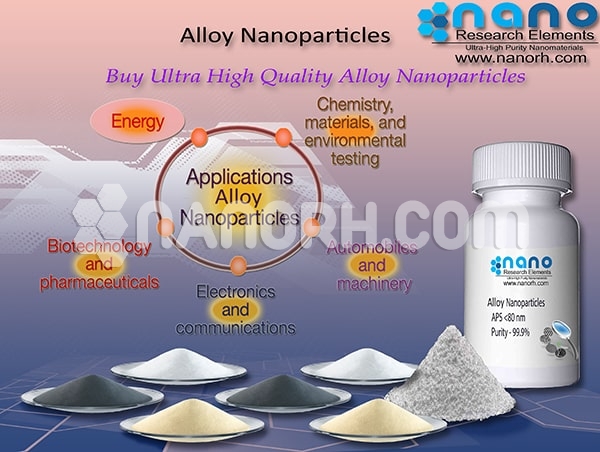ALLOY NANOPARTICLES
ALLOY NANOPARTICLES
INTRODUCTION
In materials science, the scope of properties of metallic frameworks can be incredibly reached out by taking blends of components to produce intermetallic mixes and amalgams. Much of the time, there is an improvement in particular properties after alloying because of synergistic impacts, and the rich decent variety of syntheses, structures, and properties of metallic amalgams has prompted across the board applications in hardware, designing, and catalysis. The longing to create materials with all around characterized, controllable properties and structures on the nanometer scale combined with the adaptability managed by intermetallic materials has produced enthusiasm for bimetallic and trimetallicnanoclusters, which will be alluded to as composite nanoclusters or nanoalloys.
With respect to mass compounds, an extensive variety of mixes and creations are feasible for nanoalloys. Bimetallic nanoalloys can be produced with, pretty much, controlled size and arrangement. The bunch structures and level of A-B isolation or blending may rely upon the technique and states of group age (kind of group source, temperature, weight, and so forth.).
Nanoalloys can be created in an assortment of media, for example, group pillars, colloidal arrangements, immobilized on surfaces, or inside pores. One of the significant explanations behind enthusiasm for combination nanoparticles is the way that their compound and physical properties might be tuned by changing the creation and nuclear requesting and also the measure of the groups. Actually, nanoalloys may show enchantment sizes as well as enchantment syntheses, i.e., pieces at which the compound nanoclusters present an extraordinary security. Surface structures, arrangements, and isolation properties of nanoalloys are of enthusiasm as they are imperative in deciding synthetic reactivity and particularly synergist action.
Nanoalloys are likewise of enthusiasm as they may show structures and properties which are unmistakable from those of the unadulterated basic bunch: the structures of parallel groups might be very not quite the same as the structure of the comparing unadulterated bunches of a similar size; synergism is at times seen in catalysis by bimetallic nanoalloys. They may likewise show properties which are unmistakable from the relating mass compounds because of limited size impacts, e.g., there are precedents of sets of components, (for example, iron, and silver) which are immiscible in the mass yet promptly blend in limited groups.
SORTS AND STRUCTURES OF NANOALLOYS
As a rule, nanoalloys can be arranged by their blending design (likewise named concoction requesting) and geometric structure.
MIXING PATTERNS
Four principle sorts of blending examples can be recognized for nanoalloys.
Center shell isolated nanoalloys comprise of a shell of one sort of particle (B) encompassing a center of another (A), however, there might be some blending between the shells. This blending design is normal to a huge assortment of frameworks, as we will see beneath.
Sub-group isolated nanoalloys comprise of A and B sub bunches, which may share a blended interface (left) or may just have few A-B bonds (right).
Blended nanoalloys might be either requested (left) or irregular (i.e., a strong arrangement, right). Arbitrary blended nanoalloys are frequently named "alloyed" nanoparticles in the writing, however, we will not utilize this term in the accompanying, inclining toward the expressions "blended" or "intermixed" and indicating in the case of blending is requested or irregular. The intermixed design is basic to numerous frameworks.
Multishellnanoalloys may introduce layered or onion-like substituting shells. Metastable structures of this compose were seen in recreations of the development of Cu-Ag, Ni-Ag and Pd-Ag groups; there has likewise been proof for stable A-B-An and A-B-A-B courses of action for Co-Rh and Pd-Pt bunches, individually. Recently, three-shell Pd-Au nanoparticles have been tentatively created. These nanoparticles present an intermixed center, an Au-rich middle of the road shell, and a Pd-rich external shell.
UTILIZATIONS OF NANOALLOYS
Nanoalloys have just been used in various innovatively critical territories, extending from catalysis (e.g., exhaust systems in vehicles and electrochemical power modules) to optoelectronic, attractive, and even restorative applications:
CATALYSIS
The properties, including the reactant action, of metals, might be altered and calibrated by alloying, i.e., shaping bimetallic solids. The same is valid for little metal particles and bunches, and the field of amalgam nanocatalysis is as of now drawing in a great deal of consideration in the field of catalysis, the shared impact of various neighboring molecules can prompt reactant conduct which is unique (and frequently better) than that of the monometallic groups, i.e., "synergistic impacts" are watched. Layered (center shell) bimetallic groups offer intriguing prospects for the outline of new impetuses.
Another imperative main impetus for an investigation into catalysis by Nano Alloys is the cost/uncommonness of the metals regularly utilized in catalysis. It is unmistakably alluring to utilize normal (less expensive) metals, for example, Fe, Co, and Ni, to supplant costly metals, for example, Pt and Ir, while accomplishing a NP surface whose science imitates (or betters) that of the monometallic impetus. Bimetallic NA impetuses containing Pt and Ir or Re have discovered broad use in the improving of petrochemicals, while Nano Alloys containing Pt, Pd, and different metals are of significance in vehicle exhaust systems.
BIODIAGNOSTICS
In the previous decade, there has been colossal development in the utilization of nanoparticles and different nanostructures in Biodiagnostics-atomic diagnostics for biomedical applications, e.g., for bioconjugation, as cell names, and in measures for gases, metal particles, and DNA/protein markers for an ailment. In this regard, nanoparticles offer the likelihood of upgraded vigor, affectability, and selectivity.
An inexorably vital zone of utilization of Alloy Nanoparticles is in biomedical applications, Including Biodiagnostics (e.g. exploiting the affectability of Plasmon resonances and other physical properties to the coordination of biomolecules), imaging (e.g. in fluorescence microscopy and Magnetic Resonance Imaging), medicate conveyance (regularly utilizing generally idle empty gold nanospheres and nanorods) and other helpful applications (e.g. utilizing the Magnetic Nanoparticles as a specialist for confined warming, radiation, and so on.). The mix of the measure of Magnetic Nanoparticles and the likelihood of altering their surfaces by organizing surfactants to expand their lipophilicity or hydrophilicity - or to target particular cells—makes them especially alluring in therapeutic applications.

